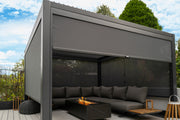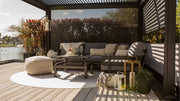
EVERYTHING YOU NEED TO KNOW BEFORE INSTALLING A PERGOLA
WHERE CAN A PERGOLA BE INSTALLED?
It is important to understand first exactly where it is sensible and appropriate to put a pergola. It should be said from the outset that a pergola must be fitted on a solid surface. Beneath the finished surface should be something that the pergola can be secured to, for example, a concrete pad. If you are having the pergola installed professionally, this surface would need to be in place before our installers arrive.
Suns Lifestyle’s experienced pergola installers do not deal with groundworks, so this is something that you need to arrange independently. Look for a company that specialises in groundworks or a local handyman with specific experience in this area, if you are not confident completing this yourself.

SLOPING SURFACES
If you are building your pergola on a sloped surface this is not a problem. Aluminium louvered roof pergolas make use of the natural fall of your surface to make it easy for rain to drain off. This means that there should always be a slight slope.
Suns Lifestyle professional fitters can adjust the legs to sit flat, using spacers up to 50mm, though this can affect the look of the footplate. If packing more than 50mm is required the legs can be reduced, but this can sometimes affect the warranty on the product as bespoke work may be required.
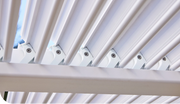
MANAGING THE GROUNDWORKS
Before you begin any groundworks, it is advisable to choose the size of the pergola that you are going to have installed. You will be provided with a floor plan. This plan will allow you to understand where the footplates for the pergola will sit. It is recommended that you use concrete pads of approximately 40x40x40cm beneath any tiles (or similar surfaces). If you have decking, you should do the same, or alternatively, add extra joists below the decking for a secure fixing.
Your surface can then be finished with tiles or decking on top. This means that when the pergola installers arrive, they are able to simply drill through any tile or decking and secure each footplate to the pads or joists below.
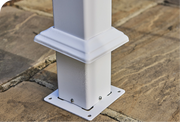
WHAT IF YOU HAVE ALREADY LAID A PATIO OR DECKING?
If you are hoping to simply affix a pergola to an existing surface, such as a patio or decking, it is a good idea to check what is beneath the surface to establish whether it is secure or not. Sand, for example, which is often used below decking, would not be secure enough, nor would composite decking without something stronger underneath.
However, there may also already be structural beams underneath where the footplates would sit. This would not be a problem per se, as long as the footplates are on structural beams that are wide enough to allow the footplate to be securely bolted.
No matter what kind of surface you are putting the pergola on, it is important to check what is beneath the surface. The pergola should not be unsecured, and if you are planning to install it without professional help, this is an important aspect to be aware of.

WHAT IF YOU ARE INSTALLING SCREENS OR SIDE OPTIONS?
If your pergola installation includes screens or side options, you should consider that the pergola needs to be levelled accurately. The legs will need to be correctly measured at both the top and the bottom for the side options to operate as designed.
The Pergola legs can then be bolted down before any side options are fitted.
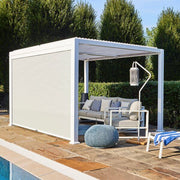
Do you need planning permission for Pergolas?
Pergolas are not considered to be a permanent structure and therefore typically do not require any kind of planning permission. Of course, it is always best to discuss this when you are making a decision on the right type of pergola to purchase. They are secured to an existing surface rather than being cemented below ground. This means that they can be disassembled and moved easily, if need be, and shouldn’t therefore require planning consent.
It is worth noting that as the height of the pergola can potentially infringe on neighbouring properties, it is best that pergolas are placed as far away from the property boundary as possible, although not essential if the pergola is placed on the natural surface. If you’re unsure about obscuring sight lines, we’d recommend consulting with your neighbours too in order to avoid any points of conflict further down the line. You should also take note of the following issues:
If the pergola is sited within 2 metres of the boundary, the maximum height should be no greater than 2.5 metres (8’2”).
Planning permission may be required if your pergola is to be installed at the front of your house.
Planning permission will be required if you live in a conservation area, or if the structure is to be installed on the side of your house between the house and the boundary.
Planning permission will be required if your property is a designated listed building.
Adding a pergola to a veranda, balcony or raised platform may require planning permission on occasion due to the increase in height, and it will need to be built in compliance with Building Regulations.
If you are unsure, we would recommend contacting your local planning authority.
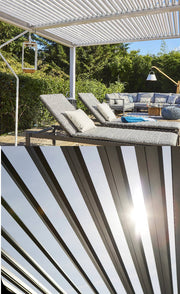
When you buy a pergola, it will come with instructions that allow it to be self-fitted, assuming that you have some basic DIY knowledge and one more person to help you. You will also need a range of tools, this may include a rivet gun depending on your chosen pergola screens. We do not provide rivet guns.
The time it will take to build your pergola is generally between 1 and 5 hours, depending on the size and model. Installing the pergola yourself does not affect the manufacturer’s 5-year warranty on the frame, nor the 2-year warranty on the screens.
If you are installing onto porcelain tiles then we’d recommend using a diamond drill fitting to mitigate cracking. Suns Lifestyle professional fitters will always use the most appropriate tools for your existing surface so if you’re unsure, we’d recommend booking our nationwide installation service.

HOW TO CHOOSE THE RIGHT PERGOLA FOR YOUR NEEDS
If you are considering buying a pergola, you might have a particular aesthetic in mind already, or you might simply know that you want a pergola, but aren’t too sure about the range of options you have available. At Suns Lifestyle, our market-leading range of sizes and heights offer solutions for garden projects large or small. The quality and longevity of your intended structure is important along with a visible and supportive team should you need guidance or advice. No matter where you are on the journey, it is important to understand the main factors when it comes to choosing a pergola. Some of the key elements of choosing a pergola include:
- Size matters – it’s no good finding the perfect pergola and falling in love with how it is going to look in your garden, before finding out that it simply doesn’t fit the dimensions of your property.
- Natural obstacles – beyond the basic dimensions of the garden, you also need to consider whether your garden has any natural obstacles that you need to overcome. For example, there might be overhanging trees, or a significantly sloped area. These don’t necessarily need to be a problem, but they can affect the kind of pergola you can install there.
- Quality materials – we use industrial grade, rust-resistant aluminium for all of our pergola components to offer enhanced quality and an incredibly robust structure. We never use steel, because we don’t like any rusting! This is why checking your foundations are key to ensure the pergola is bolted down onto a secure surface. It is also another good reason to opt for our nationwide professional installation service to guarantee a seamless finish when complete.
- Design provenance – our pergolas have been honed over time to be the best they can be, thanks to valued customer feedback. We are detail driven with an emphasis on innovation and quality. We want our pergolas to last and offer enjoyment outdoors in all seasons.
- Local weather – you will understand better than anyone how your garden is affected by weather. It may be that you require more cover from wind than you do from sunlight. You might be interested in adding weatherproof screens to the sides, or you may prefer the aesthetic of open sides or vented panels.
- Retractable pergola – if you’re looking for the ultimate in convenience, a motorised electric pergola could be the right choice. This can allow you to make the most of the sun, opt for shade or protection from the elements, as required. We would however, always recommend a louvered pergola first as we don’t think you can beat the quality and ease of the mechanism.
- No matter what kind of pergola you choose to invest in, you’ll be investing in a stunning feature piece for your garden. If you have looked through this guide and everything seems to be in order, it sounds like you’re ready to purchase.

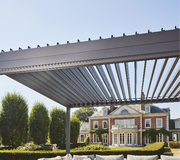
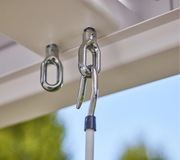
- Can the company offer guidance on foundations?
- Can the company provide floorplans for leg placement and orientation?
- Check the company you’re purchasing from can install for you
- Do they have an in-house installation team (not delivery drivers)
- Does the company have customer images of jobs they’ve installed already?
- Does the company have insurance to install your pergola properly?
- Will they bolt down for you? This is vital for a secure structure.
- Does the company physically stock the product?
- Does the company have first hand product knowledge?
At Suns Lifestyle we confidently fulfil all of the above, our installation service is tried and tested with over 3500 happy customers and we’re used to working with our customers on the best solution for their outdoor space.
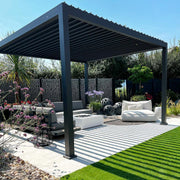
Suns Lifestyle offer an extensive range of aluminium louvered pergolas as well as options with retractable roofs. Take a look at our comprehensive louvered pergola comparison guide here to get to know our options and decide which one could be right for you. Our pergolas come with do-it-yourself instructions, but we can also provide you with a quote to use our nationwide professional installation service if required. If you have any questions about our range of products or if you need specific information on installing a pergola, our team would be happy to help. Get in contact with us today.
Explore our range of pergolas and furniture collections, to create your perfect summer set-up.

